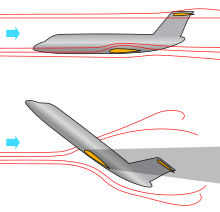Deep stall

Deep stall (German: deep demolition , "deep" meaning "large extent"), rarely as a super stable called, is a very critical flight condition of an aircraft , which occurs when in a stall (Engl. Stall at the) wing also the elevator is no longer flown against, because it is in the slipstream of the wings, and can therefore no longer contribute to changing the flight attitude .
In contrast to "normal" stalling , a deep stall can no longer be exited with control measures of the tail unit or the ailerons. It leads to extensive loss of control and almost always to the aircraft crashing .
In principle, aircraft with a T- tail unit where the elevator is higher than the wings are affected by this effect . To avoid a deep stall, so-called stick pushers were introduced: automatic systems that push the control column forward as soon as the angle of attack reaches a limit value. Practically all early passenger aircraft with a T-tail were affected by the effect or had to be redesigned accordingly, such as the BAC 1-11 , Douglas DC9 , McDonnell Douglas MD80 series and the Ilyushin Il-62 .
Occurrence of deep stalls
The following flights resulted in a deep stall and an accident:
- British European Airways Flight 548
- Aviation accident involving the Hawker Siddeley Trident G-ARPY
- British Aircraft Corporation Flight 53
- Aircraft accident involving an HFB 320 Hansa Jet near Madrid
- Bombardier Aerospace Flight 388
- West Caribbean Airways Flight 708
See also
- Full stall in paragliding acrobatics
Web links
- Ways to Prevent Deep Stall ( Memento from August 28, 2006 in the Internet Archive )